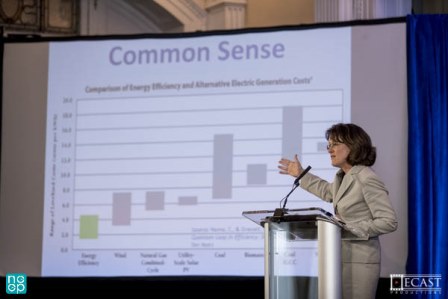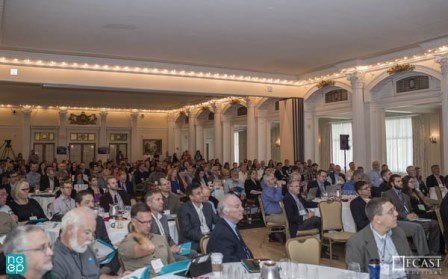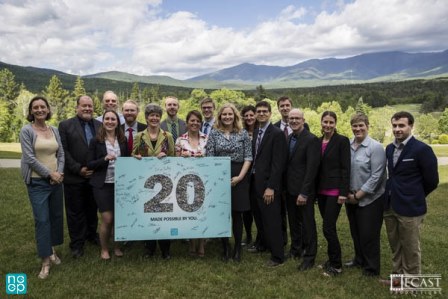By Natalie Hildt Treat | Tue, July 5, 16
Now that we’ve recovered from the Northeast Energy Efficiency Summit and 20th Anniversary Celebration held a few weeks back, NEEP staff have been taking stock of the big ideas and takeaways that percolated during our June 13-14 gathering at the Omni Mount Washington Resort in New Hampshire.
The Summit is always a fantastic opportunity to bring together policymakers, efficiency program administrators, market actors, consultants and non-profit groups to learn, engage, and network. While the clouds hung low on the mountains over Bretton Woods, the atmosphere inside was bright and lively as attendees from around the Northeast and the nation made connections, shared ideas, and challenged thinking.
As I helped prepare some of the anniversary materials, including a blog about how NEEP came to be, it struck me that NEEP was born at a conference of thought leaders not unlike our own Summit. While the “aha moment” that sparked the idea of NEEP came while founder Sue Coakley and her friend were communing with nature, it was back in the convention hall that the idea of a regional efficiency organization gained support. The rest is history, still in the making.
So, what are the big ideas, challenges to solve and new ways of doing things that might have had their seed planted at the 2016 NEEP Summit? Looking over our notes and talking to my NEEP colleagues, here are a few that struck me.
One idea that came up again and again in different sessions, not surprising to NEEP, was the importance of working regionally — whether with standardized evaluation, measurement and verification (EM&V), program offerings, electric system planning or even a regional Green Bank.
 Diane Duva, Director at the Connecticut Department of Energy and Environmental Protection noted in her plenary remarks that the cost of fragmentation of public policy is tremendous. Lack of regionalism costs communities, states, and all of us much more than when we pool resources and administration together. She reminded us that when the Northeast and Mid-Atlantic states work together, they have an economy the size of California!
Diane Duva, Director at the Connecticut Department of Energy and Environmental Protection noted in her plenary remarks that the cost of fragmentation of public policy is tremendous. Lack of regionalism costs communities, states, and all of us much more than when we pool resources and administration together. She reminded us that when the Northeast and Mid-Atlantic states work together, they have an economy the size of California!
Another affirming message is that NEEP is on the right track in our focus on Next Generation Energy Efficiency as an integral and integrated part of our clean energy future, with policies and programs that marry efficiency with demand response, energy storage, renewables and even electric vehicles.
Other overarching themes: things in the energy world are becoming more complicated, with increases in distributed resources, new technologies and lots of data. Yet the majority of customers aren’t focused on energy — they want things to be clear, easy and reliable. This means that more behind-the-scenes planning, coordination and expertise will be needed in efficiency and clean energy program development, marketing and EM&V — a good thing for the many energy service providers and consultants working in our region.
Because some of the meatier, more focused discussions happened in the topical workshops, we’ve tried to gather some key takeaways from day one. For a full description of sessions and panelists, see the Summit website — you’ll also find some great photos, and all of the inspiring Power Talks, modeled after the acclaimed TED Talk format, from day two of the Summit.
Session 1A: Home Energy: the need for savings data, plus freedom to innovate.
Research into the actual energy savings from connected devices, including Home Energy Management Systems (HEMS), will help justify more programs. Program administrators need flexibility to experiment and try new things, like claiming savings based on meter readings and pay-for-performance programs.
Session 1B: Improve financing options as projects become more complex.
Financing to supplement successful ratepayer programs can help move certain projects forward, but money is usually not the lone hurdle. As multiple demand side energy solutions are integrated, there will be more onus on financiers to understand complexity. The Investor Confidence Project (a project of the Environmental Defense Fund) aims to standardize the processes for underwriting and originating energy efficiency loans to build confidence into the marketplace. The varying rules across program provider territories and states can be difficult for property owners and lenders alike. There was a strong interest in regional collaboration, and the idea of a regional Green Bank was raised.
Session 1C: Relationships, community engagement and utility partnerships key at local level.
To make progress on building energy in municipalities, there seems to be a unique recipe for success including committed champions, strong support of utilities or other program administrators, and folks knowing their neighbors. Some of the most important work is often done in less formal settings. Communities are focused on resiliency, livability, and helping to improve efficiency of public buildings, as well as looking out for those most in need. There is a unique case to be made for saving energy and money in cities and towns.

Session 2A: Harnessing software as a solution requires sophistication and cash.
With the increase of software and analytical products to monitor large building energy use and communicate with customers, we need better ways to integrate these market offerings with utility programs. Vendors say what they need is money at the start. Because it can take months or even years to get rebates through “pay for performance” offerings, commercial customers may not even apply for incentives, so these savings aren’t fully captured or integrated with ratepayer programs. One promising innovation cited was ComEd’s Monitoring Based Commissioning, which pays for software up front.
Session 2B: Consumers value efficiency in homes; appraisers and lenders working to catch up.
To transform the real estate market, we need to unlock the value of energy efficiency in homes and buildings. A number of projects, including the Home Energy Labeling Exchange (HELIX) and building energy rating and disclosure ordinances, are helping the industry build data and gain confidence. For appraisers, they must be able to back up appraisal by quantifying the value of energy efficiency. The way for appraisers to gain competency is through courses offered by the Appraisal Institute, which has resources available on green buildings. Lenders are doing a better job at accepting the value of increased efficiency when documented by an appraiser, and consumers are increasingly expecting efficiency and photovoltaics to be properly valued when selling or buying a home.
Session 2C: To integrate EE & DR, focus on the customer.
In many states, energy efficiency has flattened demand growth, but summer peak continues to grow. Utilities and market actors are working to use two-way connected devices to save energy and demand. Water is the cheapest method to store energy behind the meter, and there is an enormous savings potential in moving to electric heat pump water heaters — from an energy efficiency perspective and in terms of demand. There is a lot left to learn in terms of wifi-enabled equipment and communication protocols, and customer comfort with ceding control to utilities. We need more pilots to figure out what will work best and serve policy goals as well as customer expectations.
Session 3C: For business customers: program clarity, funding certainty & sharing success.
New Hampshire businesses and vendors need more clarity about multi-year availability of energy efficiency resources, with popular programs often shut down just months into a year. The utilities might explore delivery of package solutions to customers – energy efficiency and demand response (DR) promoted together. Other ideas: strengthen the relationship between DR vendors and utilities to increase outreach; increase use of early success stories to sell energy efficiency; and consider development of aggregation of small businesses to get better pricing.

What do you think? What parts of the Summit inspired you to go back to your own workplace and push for change, or redouble your efforts to harness energy efficiency as the bridge to a clean energy future? Take a minute and join us in the conversation by adding your comments below.